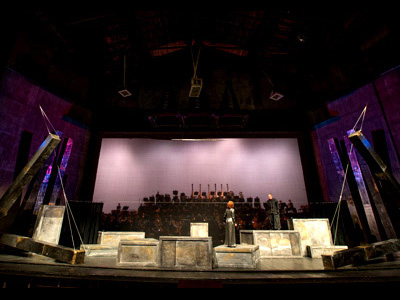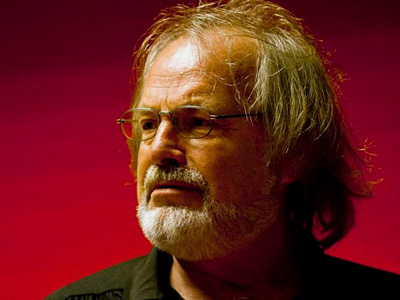
By ANDREW POWELL
Published: September 29, 2014
ERL — Nothing tests funding for the musical arts like Der Ring des Nibelungen. Then again, nothing cements a support base so decisively. Take this Austrian village of 1,452 souls and several hundred brown cows, where the eighth Ring cycle in sixteen years turned smoothly Aug. 1, 2 and 3, literally around the clock. Here a tradition of community participation in the arts — rooted in four hundred years of staging the Passion of Jesus — has since 1998 combined with local business money, political will, creative determination and a realistic setting of priorities to endow and operate the three-week-long Tiroler Festspiele, at which Wagner’s music takes pride of place.
Gustav Kuhn, 69, conductor of all these Ring cycles, helped found the festival. Often lazily dubbed a “maverick” because he shapes his own calendar and seldom works with mainstream orchestras and opera companies, Kuhn in fact roams freely less than he builds. Beyond that support base, he and the festival have partnered with a religious order in Lucca (to house a training facility for singers and other artists, the Accademia di Montegral), with orchestra pools in Minsk (to procure players for Erl), with an artist manager in London (for vocal soloists) and with a design firm and the Col Legno record label in Vienna (for graphics, CDs and DVDs). Kuhn’s music-making is if anything conventional, in contrast to that of true mavericks like Nikolaus Harnoncourt, and it fits that fellow Salzburger Herbert von Karajan was once a mentor.
An iron crown of thorns separates the village’s two performance venues. It could easily double as a symbol for the circle of fire on Brünnhilde’s rock, but its purpose was to decorate Robert Schuller’s 1,500-seat Passions-Spielhaus (1959), a cream Corbusian curlicue erected for the sacred plays and now also used for the Ring. Fifty yards away stands proof of the Tiroler Festspiele’s success: a jagged black 862-seat Festspielhaus that would have been designed by Lockheed if Delugan Meissl had not arrived first. Just two years old, this was the venue for three Bruckner symphonies over the summer, and, being insulated, it has enabled a new winter extension of the festival. Grazing fields occupy the space fronting the two buildings down to the main road, which follows the Inn River as it races out of the Tyrol into Bavaria. Parking is at a walkable distance north of the cows.
Despite its curl, the Schuller hall is laudably plain, with bare floors and a wooden roof. It offers mellow natural acoustics and easy sightlines and would be ideal for Wagner’s tetralogy except for one detail: Jesus’ suffering and resurrection required no orchestra pit. The large Ring orchestra, then, sits on risers behind a scrim while the action takes place downstage. This repurposing is evidently blessed: our Aug. 2 Walküre storm began and ended in sync with a deafening downpour on the roof.
For the second time in the festival’s history, Wagner’s three Tage were performed within the space of 24 hours, Siegfried starting at 11 p.m. and Götterdämmerung ending at 4 p.m. The tight schedule fueled advance doubts about staying alert during the music. These proved unfounded, but expectations of audience camaraderie were likewise off the mark. Instead a quiet numbness prevailed during intermissions as people ate sausages, drank beer, lounged in lime-green deck chairs and generally conserved their energy. Attendance held up, even for the wee-hour Siegfried. Hotels for miles around, most of them small, and all full, knew to expect oddly timed guest comings and goings.
Jan Hax Halama’s feeble, box-based props offered a degree of unity through the cycle but little in the way of beauty or grandeur. Lurid lighting didn’t help, and at no time did the orchestra vanish from view. The action schemes, by Kuhn, worked best in intimate exchanges such as between Wotan and Fricka, Waltraute and Brünnhilde. Siegfried’s journeys made good use of the theater’s aisles, but it was alarming — notwithstanding the custom of local involvement in Erl’s Passion plays — to see preschoolers bear open-flame torches for fire scenes down the darkened aisle steps as fire-brigade members watched from the side doors, vital moments away from any devastating potential fall.
Musically there were rewards. Compared with recent Ring cycles in Bayreuth, Vienna and Munich, Kuhn’s leadership offered consistency (beyond Christian Thielemann), imagination (unlike Franz Welser-Möst) and propulsion (trouncing Kent Nagano). He astutely judged balances, given the orchestra’s recessed position. The winds of his mostly young, partly Byelorussian orchestra played eloquently and tirelessly. Thomas Gazheli sang an incisive, many-faced Rheingold Alberich and a vivid Wanderer. Vladimir Baykov’s Walküre Wotan would be an asset on any stage. Hermine Haselböck’s firm-voiced, elegant Fricka (in both operas) recalled the young Waltraud Meier, despite some forcing. The clarion-topped, warmly intoned Brünnhilde of Mona Somm set the seal on Gotterdammerung, of which Act II — and notably its Vengeance Trio, with Michael Kupfer’s manly coke-snorting Gunther and Andrea Silvestrelli’s worthy but woolly Hagen — emerged as the cycle’s strongest unit. Anne Schuldt made a persuasive visiting Waltraute.
Compromises included Johannes Chum’s sweet-toned but unsteady Loge and the willing but imprecise choristers in Götterdämmerung. Otherwise Erl’s realistic priorities took their heavy toll. The string sound: not fully cultivated, possibly reflecting limited rehearsal time or skill levels Kuhn could not improve. Principal roles inadequately taken: the Wälsung twins, the Hunding, the Walküre Brünnhilde (cruelly mis-assigned to a low-lying lyric voice) and the Siegfrieds in both operas (the first reduced to marking his way through Lachend erwachst du Wonnige mir, the second devoid of heroism). Characteristically undeterred, this valiant village mounts two more Ring cycles next summer. Moo!
Photo © 2014 Franz Neumayr
Related posts:
Kuhn Paces Bach Oratorio
Nazi Document Center Opens
Carydis Woos Bamberg
Arcanto: One Piece at a Time
Bumps and Bychkov at MPhil

Wagner, Duke of Erl
Monday, September 29th, 2014By ANDREW POWELL
Published: September 29, 2014
ERL — Nothing tests funding for the musical arts like Der Ring des Nibelungen. Then again, nothing cements a support base so decisively. Take this Austrian village of 1,452 souls and several hundred brown cows, where the eighth Ring cycle in sixteen years turned smoothly Aug. 1, 2 and 3, literally around the clock. Here a tradition of community participation in the arts — rooted in four hundred years of staging the Passion of Jesus — has since 1998 combined with local business money, political will, creative determination and a realistic setting of priorities to endow and operate the three-week-long Tiroler Festspiele, at which Wagner’s music takes pride of place.
Gustav Kuhn, 69, conductor of all these Ring cycles, helped found the festival. Often lazily dubbed a “maverick” because he shapes his own calendar and seldom works with mainstream orchestras and opera companies, Kuhn in fact roams freely less than he builds. Beyond that support base, he and the festival have partnered with a religious order in Lucca (to house a training facility for singers and other artists, the Accademia di Montegral), with orchestra pools in Minsk (to procure players for Erl), with an artist manager in London (for vocal soloists) and with a design firm and the Col Legno record label in Vienna (for graphics, CDs and DVDs). Kuhn’s music-making is if anything conventional, in contrast to that of true mavericks like Nikolaus Harnoncourt, and it fits that fellow Salzburger Herbert von Karajan was once a mentor.
An iron crown of thorns separates the village’s two performance venues. It could easily double as a symbol for the circle of fire on Brünnhilde’s rock, but its purpose was to decorate Robert Schuller’s 1,500-seat Passions-Spielhaus (1959), a cream Corbusian curlicue erected for the sacred plays and now also used for the Ring. Fifty yards away stands proof of the Tiroler Festspiele’s success: a jagged black 862-seat Festspielhaus that would have been designed by Lockheed if Delugan Meissl had not arrived first. Just two years old, this was the venue for three Bruckner symphonies over the summer, and, being insulated, it has enabled a new winter extension of the festival. Grazing fields occupy the space fronting the two buildings down to the main road, which follows the Inn River as it races out of the Tyrol into Bavaria. Parking is at a walkable distance north of the cows.
Despite its curl, the Schuller hall is laudably plain, with bare floors and a wooden roof. It offers mellow natural acoustics and easy sightlines and would be ideal for Wagner’s tetralogy except for one detail: Jesus’ suffering and resurrection required no orchestra pit. The large Ring orchestra, then, sits on risers behind a scrim while the action takes place downstage. This repurposing is evidently blessed: our Aug. 2 Walküre storm began and ended in sync with a deafening downpour on the roof.
For the second time in the festival’s history, Wagner’s three Tage were performed within the space of 24 hours, Siegfried starting at 11 p.m. and Götterdämmerung ending at 4 p.m. The tight schedule fueled advance doubts about staying alert during the music. These proved unfounded, but expectations of audience camaraderie were likewise off the mark. Instead a quiet numbness prevailed during intermissions as people ate sausages, drank beer, lounged in lime-green deck chairs and generally conserved their energy. Attendance held up, even for the wee-hour Siegfried. Hotels for miles around, most of them small, and all full, knew to expect oddly timed guest comings and goings.
Jan Hax Halama’s feeble, box-based props offered a degree of unity through the cycle but little in the way of beauty or grandeur. Lurid lighting didn’t help, and at no time did the orchestra vanish from view. The action schemes, by Kuhn, worked best in intimate exchanges such as between Wotan and Fricka, Waltraute and Brünnhilde. Siegfried’s journeys made good use of the theater’s aisles, but it was alarming — notwithstanding the custom of local involvement in Erl’s Passion plays — to see preschoolers bear open-flame torches for fire scenes down the darkened aisle steps as fire-brigade members watched from the side doors, vital moments away from any devastating potential fall.
Musically there were rewards. Compared with recent Ring cycles in Bayreuth, Vienna and Munich, Kuhn’s leadership offered consistency (beyond Christian Thielemann), imagination (unlike Franz Welser-Möst) and propulsion (trouncing Kent Nagano). He astutely judged balances, given the orchestra’s recessed position. The winds of his mostly young, partly Byelorussian orchestra played eloquently and tirelessly. Thomas Gazheli sang an incisive, many-faced Rheingold Alberich and a vivid Wanderer. Vladimir Baykov’s Walküre Wotan would be an asset on any stage. Hermine Haselböck’s firm-voiced, elegant Fricka (in both operas) recalled the young Waltraud Meier, despite some forcing. The clarion-topped, warmly intoned Brünnhilde of Mona Somm set the seal on Gotterdammerung, of which Act II — and notably its Vengeance Trio, with Michael Kupfer’s manly coke-snorting Gunther and Andrea Silvestrelli’s worthy but woolly Hagen — emerged as the cycle’s strongest unit. Anne Schuldt made a persuasive visiting Waltraute.
Compromises included Johannes Chum’s sweet-toned but unsteady Loge and the willing but imprecise choristers in Götterdämmerung. Otherwise Erl’s realistic priorities took their heavy toll. The string sound: not fully cultivated, possibly reflecting limited rehearsal time or skill levels Kuhn could not improve. Principal roles inadequately taken: the Wälsung twins, the Hunding, the Walküre Brünnhilde (cruelly mis-assigned to a low-lying lyric voice) and the Siegfrieds in both operas (the first reduced to marking his way through Lachend erwachst du Wonnige mir, the second devoid of heroism). Characteristically undeterred, this valiant village mounts two more Ring cycles next summer. Moo!
Photo © 2014 Franz Neumayr
Related posts:
Kuhn Paces Bach Oratorio
Nazi Document Center Opens
Carydis Woos Bamberg
Arcanto: One Piece at a Time
Bumps and Bychkov at MPhil
Tags:Accademia di Montegral, Andrea Silvestrelli, Anne Schuldt, Col Legno, Commentary, Das Rheingold, Der Ring des Nibelungen, Die Walküre, Erl, Götterdämmerung, Gustav Kuhn, Hermine Haselböck, Jan Hax Halama, Johannes Chum, Michael Kupfer, Mona Somm, Review, Siegfried, Thomas Gazheli, Tiroler Festspiele, Vladimir Baykov
Posted in Munich Times | Comments Closed